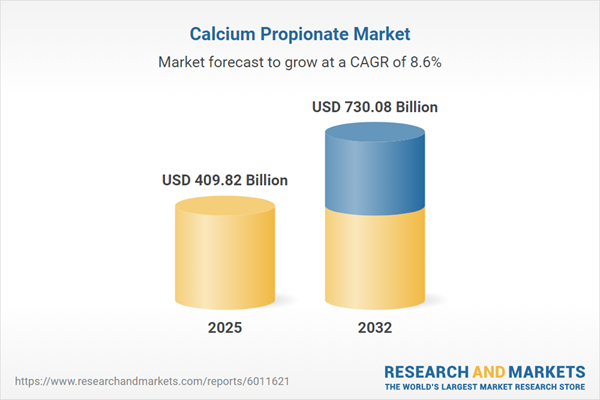Speak directly to the analyst to clarify any post sales queries you may have.
The calcium propionate market is experiencing notable transformation as industry leaders seek to safeguard reliable supply chains, implement advanced manufacturing, and navigate evolving regulations to secure competitive advantages. Organizations are innovating sourcing, technology, and strategic responses to maintain relevance across dynamic global markets.
Market Snapshot: Calcium Propionate Market Growth and Competitive Dynamics
The global calcium propionate market demonstrates strong momentum, expanding from USD 377.95 billion in 2024 to USD 409.82 billion in 2025, with forecasts predicting a further rise to USD 730.08 billion by 2032. Fueled by an 8.57% compound annual growth rate, the market’s expansion is closely linked to rising demand in food preservation, animal feed, and pharmaceutical applications. Heightened competition is driving organizations to adapt regulatory strategies and respond to industry shifts favoring clean-label ingredients. Investment in digitalization, manufacturing innovation, and diversified distribution channels is empowering enterprises to remain agile and leverage emerging trends for strategic benefit.
Scope & Segmentation: Strategic Coverage and Detailed Market Insights
- Form: Granular types, both coated and uncoated, liquid formulations (concentrated and ready-to-use), and powder variants in coarse and fine grades serve to optimize processing and fulfill varied usage requirements.
- Function: Calcium propionate extends food shelf life, stabilizes livestock feed, and maintains consistency across diverse pharmaceutical applications, addressing core quality and safety needs.
- Application: The ingredient acts as a preservative across bakery, confectionery, dairy, pet food, and processed meat sectors, ensuring reliable product performance and helping mitigate risks from transport or storage.
- Sales Channel: Distribution spans direct manufacturer sales, third-party distributor partnerships, and integration with retail networks, enabling tailored outreach and improved regional coverage.
- Regions: Commercial activity is strong in the Americas, Europe, Middle East and Africa, and Asia-Pacific. Strategic focus is required for key countries such as the United States, China, India, Japan, South Korea, Southeast Asia, Australia, and leading Latin American markets due to varying compliance requirements and consumer trends.
- Technologies: Innovations including encapsulation, controlled-release systems, and digital quality management platforms are core to improving manufacturing consistency, accelerating regulatory response, and scaling production for distinct industry needs.
- Leading Companies: Major industry players such as BASF SE, Evonik Industries AG, DuPont de Nemours, Archer-Daniels-Midland, Associated British Foods, Lallemand Inc., Addcon GmbH, Spectrum Chemical, Delavau Food Ingredients, and Xiamen Kingdomway Group are focused on incremental product development and operational agility.
Key Takeaways: Strategic Insights for Executive Decision-Making
- Prioritizing clean-label ingredient sourcing and proactive supply chain transparency strengthens compliance frameworks and builds trust with regulators and procurement partners.
- Targeted investments in advanced processing, such as encapsulation and granulation, enable customized product offerings and heightened innovation capacity for B2B stakeholders.
- Implementing digital traceability and robust quality management systems raises audit readiness and market credibility, supporting participation in tightly regulated sectors.
- Diversifying supplier networks and enhancing local sourcing flexibility help mitigate operational risk and maintain consistent supply during disruption.
- Collaboration with research institutions and industry alliances expedites adoption of new policy frameworks, supports integration of emerging technology, and smooths the transition toward reduced additive content.
Tariff Impact: Adjustments Shaping North American Supply Chains
Recent changes in United States tariff structures are pushing companies to revamp sourcing and production models. By expanding sourcing locations, increasing investment in domestic manufacturing, and refining inventory management, organizations are enhancing the resilience of North American calcium propionate supply chains.
Methodology & Data Sources
Insights draw from interviews with sector leaders, in-depth reviews of market publications, regulatory policies, and monitoring of active patents. This multi-source approach combines expert perspectives and solid market data, offering actionable guidance for procurement and strategic planning.
Why This Report Matters: Empowering Informed Executive Strategies
- Presents in-depth segmentation and sourcing strategies to help leaders balance shifting market conditions with operational risks.
- Helps organizations align with rapidly evolving regulations while optimizing supply chains and preserving continuity through industry transitions.
- Provides guidance for efficient resource allocation, targeted investments, and strategy development in calcium propionate market advancement.
Conclusion
This report offers senior executives targeted insight and actionable recommendations, enabling more resilient procurement, stronger supply chains, and confident navigation of market changes.
Additional Product Information:
- Purchase of this report includes 1 year online access with quarterly updates.
- This report can be updated on request. Please contact our Customer Experience team using the Ask a Question widget on our website.
Table of Contents
3. Executive Summary
4. Market Overview
7. Cumulative Impact of Artificial Intelligence 2025
Companies Mentioned
The companies profiled in this Calcium Propionate market report include:- BASF SE
- Evonik Industries AG
- DuPont de Nemours, Inc.
- Archer-Daniels-Midland Company
- Associated British Foods PLC
- Lallemand Inc.
- Addcon GmbH
- Spectrum Chemical Manufacturing Corp.
- Delavau Food Ingredients Ltd.
- Xiamen Kingdomway Group Co., Ltd.
Table Information
| Report Attribute | Details |
|---|---|
| No. of Pages | 181 |
| Published | November 2025 |
| Forecast Period | 2025 - 2032 |
| Estimated Market Value ( USD | $ 409.82 Billion |
| Forecasted Market Value ( USD | $ 730.08 Billion |
| Compound Annual Growth Rate | 8.5% |
| Regions Covered | Global |
| No. of Companies Mentioned | 11 |









